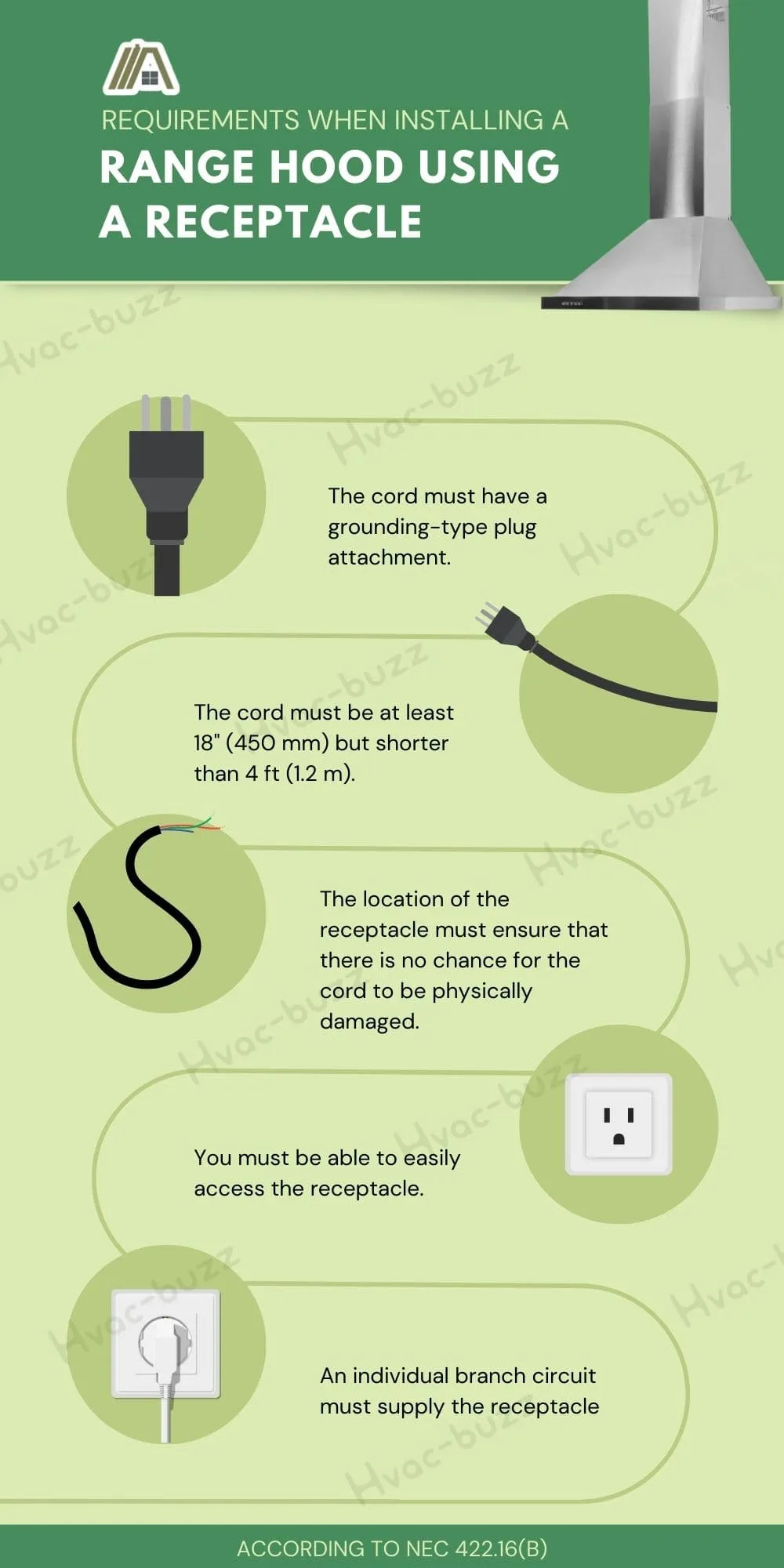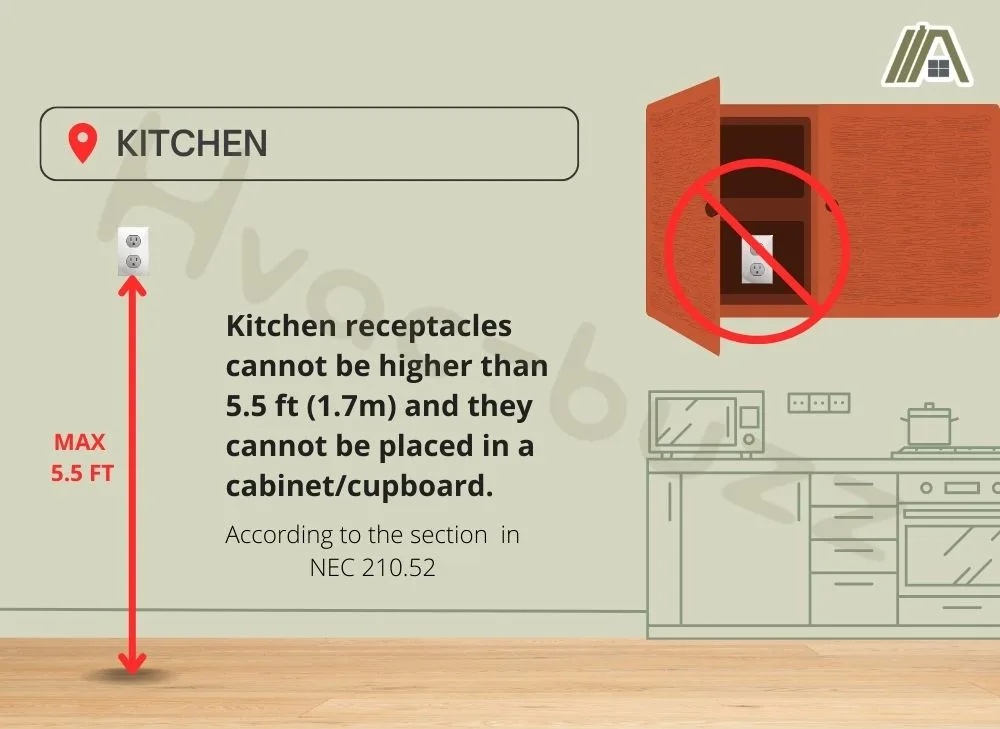Installing a range hood is not just a matter of screwing it to the wall and plugging the cord into the nearest receptacle. In order for your home to pass inspection, certain rules must be followed.
Following the National Electrical Code (NEC), which is adopted in all 50 US states (other rules may apply elsewhere), is important if you want to pass the inspection. But it also ensures that the risk of damage to both property and people is minimized.

In general, a range hood does not need to be connected to a dedicated circuit. It can be hardwired into a lighting circuit receptacle as well. However, it can never be connected to a lighting circuit via a receptacle, nor can it be connected to a kitchen receptacle in a small-appliance branch circuit.
Let’s take a look at all the possible ways it can be connected. All of the options below are compliant with the 2020 National Electrical Code. I spent more than 3 hours going through all of the points, subpoints, and exceptions to find the answers below.
You can access the code directly from the NFPA site. However, you will have to register on the site, and I must warn you, it is quite a dry document to read!
Hardwired to the Lighting Circuit
As per NEC 210.23(A) and NEC 210.23(A) (2), hardwiring the range hood to a lighting circuit is allowed when the below conditions are met:
- The range hood supports a hardwired connection.
- The range hood is rated at less than 50% of the branch circuit rating.
- So, on a 15 A circuit, the range hood must be rated at 7.5 A or less. For a 20 A circuit, it has to be rated at 10 A or less.
- Check this before you buy a range hood. Accidentally buying a hood that is rated too high will create a lot of extra work. You will have to run new thicker wires and install a higher-rated breaker.
Receptacle on a Dedicated Circuit
You will always be allowed to connect a range hood—or, indeed, any appliance—on a dedicated circuit.
The downside to doing so is that it will take up precious space in the electrical panel if it is not necessary. There are other appliances that have to be on their own circuit.
If you are going to install a range hood using a receptacle, it has to meet the following requirements (found in NEC 422.16(B)):
- The cord must have a grounding-type plug attachment. This ensures that the range hood itself is grounded. The exception would be if the range hood has equivalent protection, i.e., it is protected by double insulation.
- The cord must be at least 18″ (450 mm) but shorter than 4 ft (1.2 m).
- The location of the receptacle must ensure that there is no chance for the cord to be physically damaged.
- You must be able to easily access the receptacle.
- An individual branch circuit must supply the receptacle.

A receptacle on a dedicated circuit can certainly meet all of these requirements.
However, if you only have one or two free spaces on the panel, it is better to hardwire the range hood to a lighting circuit. This will leave room in the breaker box for the future.
Using the lighting circuit will most likely be less work as well since you don’t have to run new wires.
Hardwired to a Dedicated Circuit
You are also always permitted to hardwire the range hood to a dedicated circuit (NEC 210.22), and in this case, there are no stipulations as with plugging the range hood into a receptacle attached to a dedicated circuit.
Of course, general electrical connection guidelines must be followed and the range hood can’t be rated higher than the circuit.
Installations That Are Not Allowed
Receptacle on a Lighting Circuit
If we were to look at NEC 210.23(A), we might assume that it is OK to connect a range hood to a receptacle that is on a lighting circuit as long as the range hood is not rated higher than 50% of the branch circuit rating.
However—and this is a perfect example of why knowledge of the whole NEC is vital to correct interpretation—if we look at NEC 422.16(B), there is one statement that eliminates the possibility of using a receptacle on a lighting circuit.
Range hood wiring has to follow all of the five stipulations in this section. If not, it’s a code violation. We have already looked at these stipulations in a previous section.
Here we only have to focus on the final one:
An individual branch circuit must supply the receptacle.
An individual branch circuit is another term for a dedicated circuit. So, this stipulation clearly rules out connecting your range hood via a receptacle linked to the lighting circuit.
Connected to a Kitchen Receptacle
Kitchen outlets fall under NEC 210.52. According to this section, kitchen receptacles cannot be higher than 5.5 ft (1.7m) and they cannot be placed in a cabinet/cupboard.

Any outlet that would need to be used to plug in a range hood will most likely be placed higher than 5.5 ft or it will be enclosed in a cupboard. Either setup would be a code violation, so this is not a possibility.
In addition, NEC 210.52(B)(2) states that no other outlets can be added to the small-appliance branch circuit.
Technically you could install an outlet at a height of 5.5 ft and use a 4 ft cord (allowed by NEC 422.16(B)(4)) to connect it to a kitchen receptacle.
However, since the outlet can’t be in a cabinet, the cable will be an eyesore and probably not the best solution.
If you’re overwhelmed by all the rules that must be followed, you may wondering if a range hood is even necessary. It definitely is. However, you can hire someone else to do the installation.
I hope you found this article helpful. Please vote below and let me know if you have any suggestions to make the articles better in the future.
Thank you!
